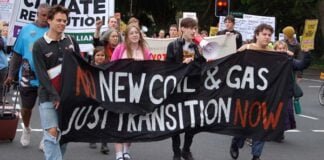As the triple crises in health, the economy and the climate rage on, the Coalition government continues to subsidise fossil fuel projects and avoid seriously cutting emissions.
While the consequences of last summer’s catastrophic, climate-induced bushfires are still being felt, scientists are warning that Australia is nowhere near on track to meet the already abysmal targets set out in the Paris agreement.
It is now clear that the Emissions Reduction Fund, the federal government’s flagship climate program established in 2015 and costing over $2.3 billion so far, has done virtually nothing to reduce Australia’s emissions.
Yet the government has clearly felt the pressure generated by the climate movement and wants to be seen to be doing something.
In May, it released its “Technology Investment Roadmap” discussion paper, which sets out the priorities for government investment in developing new low-emissions technologies. Energy Minister Angus Taylor has claimed the roadmap will help boost jobs and economic growth in the wake of the coronavirus crisis and deal with climate change at the same time.
But the scheme has rightly been described as a “roadmap to nowhere”. It contains no references to emissions reductions targets or how they will be met, and prioritises fossil fuel technologies like gas and carbon capture and storage (CCS). The Coalition has also changed the rules to allow its Emissions Reduction Fund to invest in this dubious technology.
Even “emerging” nuclear technologies are being considered, despite the admission they still face serious “engineering, cost and environmental challenges”.
CCS has been promoted for years by the fossil fuel industry as a magic answer allowing the continued burning of coal and gas, where carbon released by burning fossil fuels is simply captured and stored underground. But as Friends of the Earth put it, “Despite decades of research and $1.3bn of public funds, carbon capture and storage is still unproven”. Even Robert Murray, CEO of giant US coal company Murray Energy has admitted, “It is neither practical nor economic”.
And there are doubts amongst scientists that CCS can safely keep carbon stored underground without it escaping into the atmosphere.
The Morrison government’s embrace of CCS is a clear admission of its unwillingness to rein in the fossil fuel industry and its determination to prioritise profits over the future of the planet.
Renewable technologies like wind and solar are included in the roadmap, but there is no discussion of large scale public investment, despite the admission that renewable energy is now the cheapest option. And while a real transition would require massive public investment, the entire scheme is premised on private ownership, including of energy transmission and distribution.
Submissions on the roadmap from the Clean Energy Council, the Australian Academy of Technology and Engineering, the ACTU and the Grattan Institute recommending investment in renewable energy, modifications to the grid and household energy efficiency, have so far been ignored.
The direction of the government’s new climate policy is also clear in the work of the National Covid-19 Coordination Committee (NCCC). The NCCC, appointed by Prime Minister Scott Morrison to guide an economic recovery out of the coronavirus crisis, is stuffed full of individuals with ties to the fossil fuel industry, including billionaire former CEO of Fortescue Metals, Neville Power and Andrew Liveris, a former Trump advisor.
The committee has been pushing for a gas-led recovery, with the aim of boosting Australia’s fossil fuel exports, and has reheated a previously discredited proposal for a trans-Australia pipeline that would link Western Australia with the East-coast gas market.
An expansion of the gas industry will mean opening up vast swathes of land to fracking and delaying the shift to renewables. While gas has been touted as a lower emissions alternative to coal, the methane that leaks out into the atmosphere during mining is 86 times more potent than carbon dioxide over 20 years.
Labor
In a further slide to the right since losing last year’s election, Labor leader Anthony Albanese has moved to further embrace the Coalition’s climate policy, saying that he wants to establish a bipartisan approach to climate and that the roadmap is a “largely factual” document.
Labor has even shown support for CCS and extending the lives of coal-fired power stations.
However reports produced by groups like Climateworks, the Climate Council and Beyond Zero Emissions have shown that a transition to renewable energy could create tens of thousands of new jobs. And a climate movement that orients to workers could demand that these be proper, union jobs with good conditions.
In the lead up to the budget in October, climate and union activists will have to pressure the government to invest in renewable energy as a response to the unemployment crisis, not obsolete fossil fuel technologies.
By Caitlin Doyle





